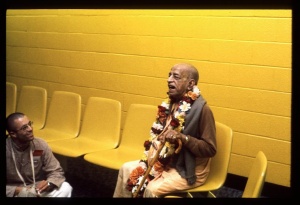CC Antya 2.10 (1975)

A.C. Bhaktivedanta Swami Prabhupada
Below is the 1996 edition text, ready to be substituted with the 1975 one using the compile form.
TEXT 10
- sapta-dvīpera loka āra nava-khaṇḍa-vāsī
- deva, gandharva, kinnara manuṣya-veśe āsi’
SYNONYMS
sapta-dvīpera loka—people from all of the seven islands within the universe; āra—and; nava-khaṇḍa-vāsī—the inhabitants of the nine khaṇḍas; deva—demigods; gandharva—the inhabitants of Gandharvaloka; kinnara—the inhabitants of Kinnaraloka; manuṣya-veśe—in the form of human beings; āsi’—coming.
TRANSLATION
People from all over the universe, including the seven islands, the nine khaṇḍas, the planets of the demigods, Gandharvaloka and Kinnaraloka, would go there in the forms of human beings.
PURPORT
For an explanation of sapta-dvīpa, see Madhya-līlā, Chapter Twenty, verse 218, and Śrīmad-Bhāgavatam, Fifth Canto, Chapters Sixteen and Twenty. In the Siddhānta-śiromaṇi, Chapter One (Golādhyāya), in the Bhuvana-kośa section, the nine khaṇḍas are mentioned as follows:
- aindraṁ kaśeru sakalaṁ kila tāmraparṇam
- anyad gabhastimad ataś ca kumārikākhyam
- nāgaṁ ca saumyam iha vāruṇam antya-khaṇḍaṁ
- gāndharva-saṁjñam iti bhārata-varṣa-madhye
“Within Bhārata-varṣa, there are nine khaṇḍas. They are known as (1) Aindra, (2) Kaśeru, (3) Tāmraparṇa, (4) Gabhastimat, (5) Kumārikā, (6) Nāga, (7) Saumya, (8) Vāruṇa and (9) Gāndharva.”